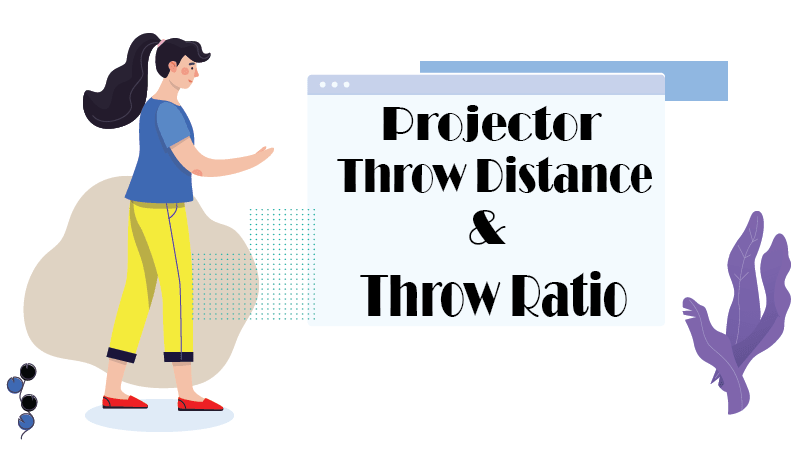Today, we’ll discuss one of the most important critical factors of a projector called ‘throw distance.’ I explained it in simple words so that you can calculate your projector’s throw distance and throw ratio.

Purchasing the right type of projector to suit your presentational and entertainment needs could be anything but a walk in the park. Whether it’s the projector itself or the projector’s screen, certain inherent technical specifications of the projector are important factors that you need to consider in order to make the right choice. One of such specifications is the projector’s throw distance, and understanding this concept puts you ahead when comparing different projector options.
What About Projector’s Throw Distance?
Simply put, a projector’s throw distance is the maximum allowable distance between a projector and the screen where the projected image is being cast unto.
It’s an essential factor that helps in determining where the projector would be in your room setting to ensure the best viewing experience.
A projector having a small throw distance should be as close as possible to the projector’s screen as opposed to that with a larger throw distance provided that the size of the projected image remains constant.
It’s common to see projectors with a throw distance as; one foot of projection screen width to every two feet between the projector’s lens and the screen.
How To Calculate Your projector’s throw ratio?
In order to easily determine the throw distance of a projector, there is a handy formula for you—it is the throw ratio of your projector.
Don’t worry! It’s not like one of those complex trigonometric formulas that made high school math seem like rocket science; it’s pretty simple.
It is the result of dividing the distance between the lens of the projector and the screen of projection (it’s throw distance) by the width of the projected image.
For example,
Throw ratio = Throw Distance/ Image width.
Given that you know the value of some parameters in the formula, you can easily calculate the values of the rest.
For instance,
Let’s say you went to the market and purchased a projector with a throw ratio of 2.0, as is common amongst most projectors; this can be interpreted to mean that for every foot of image width, the projector needs to be at least 2 meters away from the screen to get the best viewing experience.
With this basis, you can now scale up to any given image width.
For example,
an image width of 3-feet will best be enjoyed if the projector is 6 feet away from its screen.
Conversely, you can also calculate the best image size to be viewed by a projector placed anywhere in a room setting, given its throw ratio.
Here is the projector throw distance calculator.
Why Knowledge of Throw Distance and Throw Ratio of a Projector is Important?
Most times, purchasing a projector is the easy part. However, deciding the right position in your space to set it up or determining the correct screen size to purchase with it could be a herculean task.
Manufacturers make projectors with distinct throw distances and throw ratios to suit the projection needs of various room settings; therefore, it’s solely up to you to make the right choice using the product’s specification as a guide.
For instance, the throw distance is vital in determining how far your projector needs to be from its screen and how big the screen should be for optimum viewing experience.
Sometimes, the placement of the projector is already predetermined.
For instance, a projector-stand at the back of a large auditorium or a designated stool in front of an interactive board in a classroom.
To this end, making alterations to its positioning wouldn’t be feasible. The go-to action in such cases is to purchase extra or different lenses to either increase or decrease the projector’s throw distance.
A short-throw lens would be required if the projector is too close to its screen; otherwise, you’ll see blurred images on the projector’s screen.
On the other hand, a long throw lens would be needed if the projector’s position is too far from the screen unless the image projected becomes unclear.
Another option is to purchase a projector that is already pre-configured for long or short throw distances; thus, it comes with pre-installed lenses.
Therefore, as a word of advice, always ensure the size of your space influences your decision when purchasing a projector.
Conclusion: Which one – A short-throw or a long-throw lanse?
Short Throw Distance Lenses
Projectors with short throw lenses are suitable for small room settings because they are capable of projecting larger images at a short throw distance.
They are very portable and can be at distances of 1 to 2.5m from the projector screen. Great for personal home theatres and mega gaming setups.
Long Throw Distance Lenses
If you require projection for a larger, expansive space such as an auditorium or a hall, then a projector with a long throw lens would be the best fit.
They are capable of projecting smaller, crisp images from a distance away and are, therefore, used to maintain image quality as the projector is moved further away from the screen.

